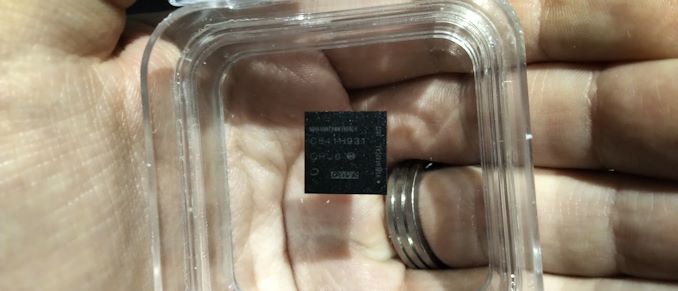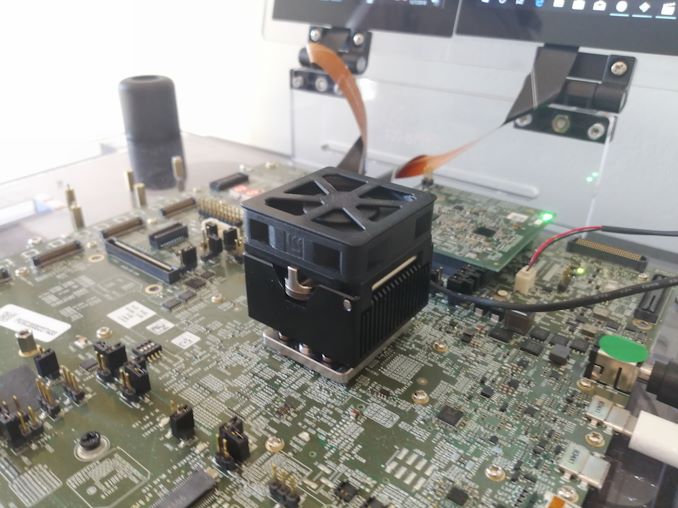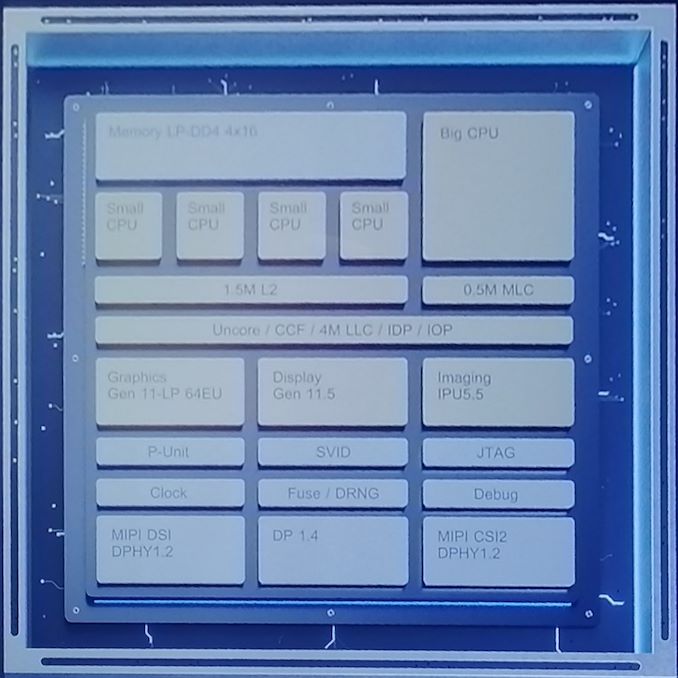Intel's Architecture Day 2018: The Future of Core, Intel GPUs, 10nm, and Hybrid x86
by Dr. Ian Cutress on December 12, 2018 9:00 AM EST- Posted in
- CPUs
- Memory
- Intel
- GPUs
- DRAM
- Architecture
- Microarchitecture
- Xe
Intel’s First Fovoros and First Hybrid x86 CPU: Core plus Atom in 7 W on 10 nm
Perhaps someone will correct me, but I can’t ever remember a time when Intel has put multiple x86 cores of different configurations on the same bit of silicon (ed: Intel Edison). Ever since Arm starting doing it with its big.Little designs in smartphones, a perennial question was if Intel was going to do something similar, either with big and small Atom cores, or by moving a high-performance Core into the mix. When Intel left the smartphone and tablet market, we assumed the idea was dead. But, like a reanimated zombie, it has risen from the grave. Enter Intel’s Hybrid x86 CPU.
This tiny 12x12 package is built using Intel’s Fovoros technology, using a 22FFL IO chip as the active interposer connected with TSVs to a 10nm die that contains both a single Sunny Cove core and four Atom (Tremont?) cores. This tiny chip is smaller than a dime, and is designed to have a 2 mW standby power. It would appear that this chip is destined for mobile devices.
Here’s the manufacturing diagram, showing the idea that POP memory is placed over the Fovoros design to give the final product. Very much like a mobile chip.
The demo system that Intel had on display looked similar to the previous Sunny Cove design, however this heatsink was smaller and it had a few different connectors. We were told that this chip will support PCIe for M.2 as well as UFS, both of which are found in mobile. There also looked like a couple of SIM card connectors on this motherboard.
The key part of this discussion however is this block diagram that was on one of the Intel slides. Here we see a single ‘Big CPU’ with 0.5 MB of private medium level cache, four ‘Small CPU’s with a shared 1.5 MB L2 cache, an uncore that has 4MB of last level cache, a quad-channel memory controller (4x16-bit) with support for LPDDR4, a 64 EU design with Gen11 graphics, the Gen 11.5 display controller, a new IPU, MIPI support with DisplayPort 1.4, and all of this in a tiny package.
Seriously though, this has the potential to be a large revenue stream for Intel. They’ve made this chip, which allows the cores to enter C6 sleep states when not in use, that has a die size smaller than 12x12mm (144 mm2), and target the sub-7W fanless device market. That’s with a big Core, four Atom cores, and a GT2 64 EU design.
Intel actually says that the reason why this product came about is because a customer asked for a product of about this performance but with a 2 mW standby power state. In order to do this, Intel created and enhanced a number of technologies inside the company. The final product is apparently ideal for the customer, however the chip will also be made available for other OEMs.
In our Q&A session with the senior members of Intel, it was clear that this technology is still in its infancy, and Intel now has a new toy to play with. Jim Keller stated that internally they are trying lots of new things with this technology to see what works and what would make a good product, so we should be seeing more Foveros designs through 2019 and 2020.















148 Comments
View All Comments
f1nalpr1m3 - Wednesday, December 12, 2018 - link
Yeah, they totally put it together in three weeks and everything.Get a clue.
pkgtech - Thursday, December 20, 2018 - link
For years Sohail Ahmed was the roadblock to Intel doing any creative package technology by blocking silicon support. He finally was shown for what he was after 2+ year process technology delays and re-invented this. Good riddance SohailAdonisds - Wednesday, December 12, 2018 - link
How do the Intel process delays influence their microarchitecture plans? 10 nm was already supposed to be here and with it its new microarchitecture, Ice Lake. Does the Ice Lake design continue to get improved as the delays kept happening or was it finalized years ago? Why? What about the microarchutectures succeeding Ice Lake?III-V - Wednesday, December 12, 2018 - link
This is Ice Lake. Might be a 14nm port (unclear at this point why the name change), but it's at the very least a close relative.III-V - Wednesday, December 12, 2018 - link
Actually, given the name on the heat sink, it is probably just straight up Ice LakeHStewart - Thursday, December 13, 2018 - link
I believe the road map states Ice Lake will be on 10nm. More importantly it will be on Sunny Cove which is significant update to Architexture.AdhesiveTeflon - Wednesday, December 12, 2018 - link
Intel and their naming scheme....they should call one "blue slushie lake"prisonerX - Wednesday, December 12, 2018 - link
Plans? Intel are in full scale panic mode right now. I'm sure they have new plans every week.jjj - Wednesday, December 12, 2018 - link
LOL you went in full fanboy mode with the 144mm package being small.The package is that size for PoP, the die is much much smaller, they can fit way more 10nm cores than that in such a large area, even without a base die.
Anyway, there are no relevant details on Foveros and that's problematic. The first question is cost, then you would want to know details about pitch and so on. Intel is by no means the first to announce such a solution so the details are what matters.
This is how you get to a 3D monolithic die in some years so any foundry that wants to stay in the most advanced node game, needs to push the packaging roadmap.
Ian Cutress - Wednesday, December 12, 2018 - link
I specifically said the package was small, and the die was smaller than the package.